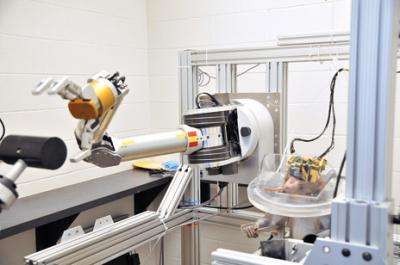June 3, 2010 weblog
Advanced Robotic Arm Controlled by Monkey’s Thoughts (w/ Video)

(PhysOrg.com) -- Researchers at the University of Pittsburgh have demonstrated a monkey controlling an advanced robotic arm by using its thoughts. The experiments were led by Dr. Andrew Schwartz, a professor of neurobiology and involved a high degree of complexity in the robotic arm, the level of control, and the intricacy of the manipulations.
This is not the first time that Dr. Schwartz implanted sensors in a monkey’s brain to control a robotic arm. Back in May of 2008 experiments were conducted by Dr. Schwartz, using a simpler mechanical arm, to teach a monkey to feed itself. This was a four-degrees-of-freedom arm with shoulder joints, elbow, and a simple gripper.
In the video above monkeys in the Dr. Schwartz’s lab are able to move a robotic arm to feed themselves marshmallows and chunks of fruit while their own arms are restrained.
In the experiments conducted this year two sensors were implanted into the monkey’s brain. One was implanted in the hand area and the second in the arm area of its motor cortex. The sensors monitor the firing of motor neurons and send data to the computer that translates the patterns into commands that control the robotic arm.
In the video above the monkey (right side of video) uses its right arm to tap a button which triggers the robotic manipulator to position a black knob to an arbitrary position. The monkey is then seen controlling its articulated robotic arm to grasp the knob.
After touching the knob the monkey places its mouth on a straw to be rewarded with a drink. By constant repetition the monkey eventually starts placing its mouth on the straw before touching the knob knowing that a drink is coming.
This advanced robotic arm has seven-degrees-of-freedom as compared to the four-degrees-of-freedom arm back in 2008. The added three more degrees of freedom adds an articulated wrist which can perform pitch, roll and yaw movements. These movements enable the monkey to precisely turn the knob by rotating the mechanical wrist.
By putting the brain in direct communications with machines, researchers will one day be able to engineer and operate advanced prosthetics in a natural way to help paralyzed people live a close to normal life.
As of this writing Dr. Schwartz and his colleagues have not published the detailed results of their latest experiments.
You can now listen to all PhysOrg.com podcasts at www.physorg.com/podcasts-news/
© 2010 PhysOrg.com


















